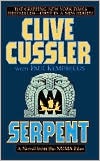Category Archives: Clive Cussler
Notes from Thrillerfest
Collaborating with Cussler
Our guest today is New York Times bestselling author, Paul Kemprecos. Paul is the co-author with Clive Cussler of eight NUMA Files books. Before collaborating with Cussler, he had written six underwater private detective books set on Cape Cod. His first book won a Shamus Award for best original paperback. He and his wife live on Cape Cod
 People often ask me about the nuts and bolts of my collaboration with Clive Cussler. I must admit I’m as mystified about the process as when we started writing the NUMA Files series around ten years ago at a time only a few fiction writers were working together. Clive still kids me about making the jump from a regional Cape Cod private eye to world-wide thriller-adventure novels but at the time it was a daunting proposition. And still is.
People often ask me about the nuts and bolts of my collaboration with Clive Cussler. I must admit I’m as mystified about the process as when we started writing the NUMA Files series around ten years ago at a time only a few fiction writers were working together. Clive still kids me about making the jump from a regional Cape Cod private eye to world-wide thriller-adventure novels but at the time it was a daunting proposition. And still is.
I decided from the first not try to be another Cussler. The Grandmaster of Adventure is several inches taller than I am, so there was no way I could fill his shoes. And we had differing backgrounds and styles of writing. I would simply write the best adventure story I could, keeping the tone–whatever that is–similar to that of the Pitt novels.
Clive sent me the bios of the NUMA Special Assignments Team and it was up to me to flesh them out as believable characters. Then we were off and running on the book that would become Serpent.
 With a cast of characters in place, next there had to be a story line. Clive suggested having the lost continent of Atlantis found under Antarctic ice. I gathered some material and was digging through the pile when he called and said he was going to use his suggested story line in the Dirk Pitt novel that would become Atlantis Found. He had another idea: a conspiracy to keep secret contact with America that pre-dated Columbus. It was pretty sketchy, but I said I would see what I could do. I said I had been thinking of using the Andrea Doria sinking in one of my PI novels and thought that the collision with the Stockholm that led to the sinking of the Italian luxury liner might be a good way to start a NUMA File. The collision could have been a deliberate act I suggested. He thought that was a good idea and suggested that the ship was sunk to hide an object on board that would unravel the conspiracy. Start writing, he said.
With a cast of characters in place, next there had to be a story line. Clive suggested having the lost continent of Atlantis found under Antarctic ice. I gathered some material and was digging through the pile when he called and said he was going to use his suggested story line in the Dirk Pitt novel that would become Atlantis Found. He had another idea: a conspiracy to keep secret contact with America that pre-dated Columbus. It was pretty sketchy, but I said I would see what I could do. I said I had been thinking of using the Andrea Doria sinking in one of my PI novels and thought that the collision with the Stockholm that led to the sinking of the Italian luxury liner might be a good way to start a NUMA File. The collision could have been a deliberate act I suggested. He thought that was a good idea and suggested that the ship was sunk to hide an object on board that would unravel the conspiracy. Start writing, he said.
I sat down with some books and a diagram of the Doria and the prologue turned out surprisingly well. Clive said it was great and told me to keep going. I knocked off another hundred pages. This time Clive called to say the second batch of pages I had sent kinda stunk. I agreed with him, and said I was badly in need of some guidance. A few weeks later I flew out to Scottsdale, Arizon where Cussler lives. I was convinced that I had gotten in over my head with the NUMA Files, but we spent a couple of days going back and forth and carved out the plot and characters that would put Serpent on the best-seller lists.
 This is pretty much the template we have followed in our collaboration, right down to our latest book, Medusa. I run some concepts by him. He says yes, no or maybe and offers suggestions. I start writing, get into trouble about half way through the manuscript, then I fly out to have a story conference that sets things straight and head home to write the rest of the book. He hasn’t called recently to say something stinks, usually saying it indirectly by hinting I might want to come at something a different way. We’ve worked together long enough for me to pick up on his suggestions, however subtle they may be. I’ve learned to trust his instincts even if they run counter to my own. When he keeps returning to a subject it usually means this is a good thing to keep in the story.
This is pretty much the template we have followed in our collaboration, right down to our latest book, Medusa. I run some concepts by him. He says yes, no or maybe and offers suggestions. I start writing, get into trouble about half way through the manuscript, then I fly out to have a story conference that sets things straight and head home to write the rest of the book. He hasn’t called recently to say something stinks, usually saying it indirectly by hinting I might want to come at something a different way. We’ve worked together long enough for me to pick up on his suggestions, however subtle they may be. I’ve learned to trust his instincts even if they run counter to my own. When he keeps returning to a subject it usually means this is a good thing to keep in the story.
Every writing duo comes at the task in its own way. Some write alternating chapters. Or one person works on story while the other does the actual writing and they meet somewhere in the middle. James Patterson said at a Thrillerfest talk that he writes long outlines for others who do the actual writing.
I think that whatever way works is the right way. Clive and I have a loose arrangement, but we are on the same creative wavelength. I will never be the story-teller Clive is. And he says I’m a better writer than he is. Even so, when we get into our Good-Guy, Bad-Guy discussions, we are talking the same language.
I guess it works. Medusa was scheduled to come in at number two today, June 2, on The New York Times bestseller list.
Have you ever collaborated with another author, and if so, how do you approach the task? If you haven’t, do you think you could? And as a reader, how do you feel about books written by two writers as opposed to single authors?
Watch for future Sunday guest blogs from Robert Liparulo, Linda Fairstein, Julie Kramer, Grant Blackwood, and more.

